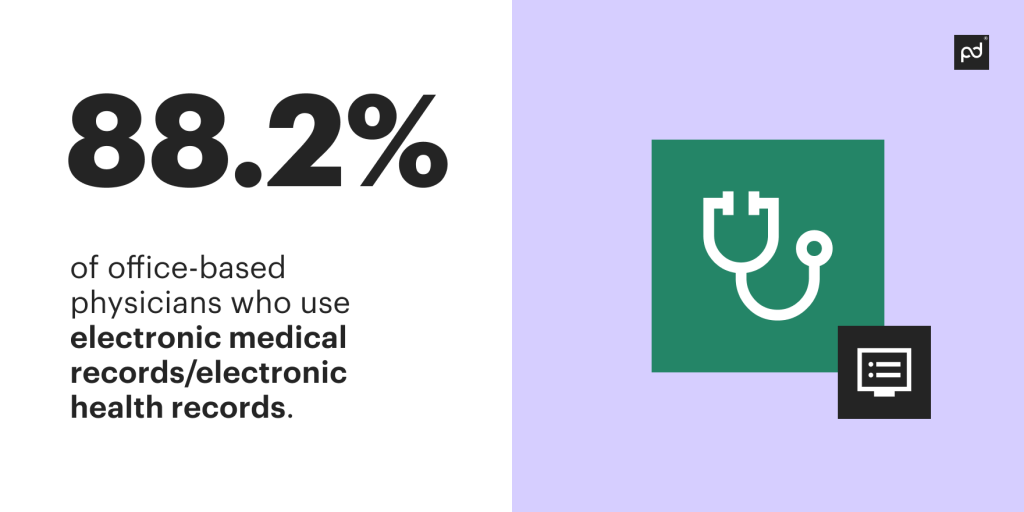In today’s fast-paced digital world, tech businesses are always on the lookout for smart ways to simplify healthcare privacy processes and stay on the right side of the federal law – especially when it comes to protected health information (PHI).
Of course, you can’t properly protect sensitive healthcare info, ensure message integrity, and safeguard protected health information – without adhering to the health insurance portability and accountability act (HIPAA) rules.
Which is why understanding the ins and outs of HIPAA compliant electronic signature is a crucial component to the use of e-signatures in the healthcare industry.

So what is HIPAA compliant digital signature software? How do you streamline the notice of privacy practices?
What apps are available on the market?
Maybe you’re curious about how healthcare organizations safeguard against unauthorized access?
Let’s dive in and see how we can revolutionize your approach to the HIPAA authorization electronic signature compliance process together.
Key takeaways:
- What is a HIPPA e-signature?
- What is ePHI?
- What types of service providers can use electronic signature software?
- What is the best electronic signature software for healthcare organizations and providers?
What is the HIPAA Privacy Rule?
Healthcare providers are likely familiar with the HIPAA Privacy Rule, which establishes national standards for protecting PHI.
Under HIPAA, healthcare organizations must adhere to strict guidelines regarding the use and disclosure of protected health information (PHI).
Note: HIPAA requires payers to implement electronic signature in order to safeguard information.
As outlined by the Centers for Medicare and Medicaid (CMS), HIPAA mandates that the Department of Health and Human Services (HHS) “establish national standards for electronic transactions to enhance the efficiency and efficacy of the nation’s healthcare system.” 1
CMS states that any healthcare provider receiving payment from a health plan or insurance company must adhere to HIPAA regulations when conducting electronic transactions and sending patient data.
Additionally, these providers are required to establish written agreements with business associates, such as clearinghouses and independent medical transcriptionists, to ensure compliance with HIPAA regulations.
What is the Uniform Electronic Transactions Act (UETA)
Under the UETA, electronic signatures are granted the same legal status as traditional signatures, provided certain requirements are met.
The UETA, along with the Electronic Signatures in Global and National Commerce Act (ESIGN Act), provides a framework for electronic transactions that comply with HIPAA standards.
If you’re wondering whether digital signatures meet HIPAA requirements, the answer is yes.
To further ensure compliance, healthcare providers must establish Business Associate Agreements (BAAs) with any third-party service providers handling PHI.
What is electronic protected health information (PHI)?
Electronic Protected Health Information (ePHI) refers to any individually identifiable health information that is created, stored, transmitted, or received electronically.
Electronic health records include patient data such as patient medical records, treatment histories, laboratory results, and billing information that is stored or transmitted electronically.
For HIPAA compliance, it’s essential to have a clear policy on e-signature retention to ensure that all electronic signatures are securely stored and easily accessible when needed for audits or legal purposes.
ePHI is protected under HIPAA to ensure its confidentiality, integrity, and availability.
Compliance with HIPAA regulations is necessary to safeguard ePHI and protect patients’ privacy and security.
When signing documents electronically for HIPAA compliance, it’s crucial to ensure that each signatory understands the implications of using this method for sensitive patient information.
What is a HIPAA compliant electronic signature?
HIPAA electronic signatures are used to authenticate and authorize electronic transactions involving PHI, such as consent forms, treatment agreements, or release of medical records.
These electronic signatures must meet certain standards outlined by HIPAA to ensure the security and integrity of the signed documents and the protection of patients’ privacy rights.
The importance of keeping protected health information (PHI) safe.
Data security is top priority for healthcare organizations sending electronic health records.
Unfortunately, obtaining PHI from healthcare records is often the target of cybercrime.
From 2009 to 2023, over 5,800 healthcare data breaches, each involving 500 or more records, were reported to the Department of Health and Human Services (HHS) Office for Civil Rights (OCR).2
These breaches exposed or disclosed more than 519 million healthcare records, exceeding the population of the United States by 1.5 times.
E-signature software for healthcare organizations
By now you realize that incorporating electronic signatures isn’t just about signing documents — it’s about revolutionizing your entire workflow.
One of the most powerful features of e-signature software is the ability to upload critical forms and create templates for faster and more efficient processing.
Imagine a world where patient forms, consent forms, disclaimers, and acknowledgement letters are all at your fingertips, ready to be filled out and signed in a matter of minutes.
With e-signature software like PandaDoc, this becomes a reality.
By digitizing these essential documents, you not only save time and resources but also enhance the overall experience for both your staff and your patients.
Say goodbye to paper-based delays and hello to a streamlined, paperless future.
5 non-negotiable HIPAA electronic signature standards to look for
When selecting e-signature software for HIPAA compliance, healthcare organizations should prioritize features that align with their specific needs.
These may include:
- Advanced Encryption: Ensure that the software employs industry-standard encryption protocols to safeguard sensitive data.
- Audit Trails: Look for solutions that provide detailed audit trails, allowing businesses to track every step of the signing process for compliance purposes.
- Access Controls: Implement access controls to restrict document access to authorized personnel only, minimizing the risk of unauthorized data breaches.
- Integration Capabilities: Choose software that seamlessly integrates with existing systems and workflows, minimizing disruption to operations.

What are the four requirements for an electronic signature to be valid?
HIPAA-compliant electronic signatures must satisfy four key criteria for validity. First, it needs to authenticate the signer, meaning their signature must be uniquely identifiable and verifiable.
Second, the signature must ensure the signed document or data’s integrity, preventing undetected alterations after signing.
This preserves the integrity of health records by preventing unauthorized alterations.
Third, the non-repudiation aspect of electronic signatures ensures signers cannot deny signing, providing legally verifiable proof of authorship.
Finally, the signing process needs to be auditable, meaning it should track and log all steps, timestamps, etc., for compliance demonstrations during audits.
Meeting these four criteria guarantees the legal validity and security of electronic signatures, protecting PHI in healthcare.
Let’s take a look at the options available to help you streamline and process your electronic documents.
Best HIPAA compliant electronic signature software
| eSign Software | Pricing | Pros | Cons | Rating (out of 5) |
|---|---|---|---|---|
| PandaDoc | Subscription-based pricing with plans for individuals, small businesses, and enterprises. | – Comprehensive document management features. – Customizable templates for healthcare documents. – Integration with popular CRM and productivity tools. – Competitive pricing |
Some users report a learning curve for advanced features. | 5.0 |
| DocuSign | Subscription-based pricing with tiered plans based on usage. | – Industry leader in e-signature solutions. – Robust security features. – Integrates with various healthcare systems. |
– Higher pricing compared to some competitors. – Steeper learning curve for advanced features. |
4.4 |
| HelloSign | Subscription-based pricing with plans tailored for businesses of all sizes. | – User-friendly interface. – Customizable templates for healthcare forms. – Seamless integration with popular productivity tools. |
– Limited advanced features compared to other options. – Pricing may become expensive for large organizations with high usage. |
4.3 |
| Adobe Sign | Subscription-based pricing with plans designed for businesses of all sizes. | – Integration with Adobe Acrobat for comprehensive document management. – Strong compliance and security features. – Customizable workflows for healthcare processes. |
– Pricing can be higher compared to standalone e-signature solutions. – Some users may find the interface overwhelming. |
4.0 |
PandaDoc robust security features and customizable templates align perfectly with HIPAA regulations, ensuring the confidentiality and integrity of sensitive patient information at every step.
With encrypted document storage, secure electronic signatures, virtual data rooms, audit trails, and granular access controls, PandaDoc provides the peace of mind you need to confidently manage contracts while adhering to HIPAA guidelines.
Benefits to healthcare providers beyond compliance
While achieving HIPAA compliance is a top priority, the benefits of e-signature software extend beyond regulatory requirements.
Healthcare professionals may be surprised at the slew of benefits esignature provides outside of protecting PHI, including:
- Improved Efficiency: Streamline document workflows and reduce administrative overhead associated with manual paperwork.
- Enhanced Customer Experience: Offer patients a seamless, digital signing experience, improving satisfaction and loyalty.
- Cost Savings: Eliminate expenses related to printing, storing, and managing paper documents, resulting in long-term cost savings.

Here’s a quick snapshot of just a few of the templates you can customize, send, sign, and store securely:
- Hospital agreement template
- Home Health Care Template
- Health Coaching Agreement Template
- Pharmacy Services Agreement Template
Real PandaDoc customers. Real results.
Everybody can just live in PandaDoc,” she said. “I use this analogy where PandaDoc is the house and the workspaces are the rooms inside. It’s so clean, so straightforward and easy to understand. It’s our hub.
TheKey
It’s minimal work and the documents look beautiful.
Werfen
How long will it take to onboard your medical team to the e-signature platform?
Transitioning your administrative department to PandaDoc?
Wondering how long it’ll take to get your team up and running smoothly?
Let’s explore what you can expect when you begin onboarding your healthcare team to PandaDoc and how we can provide assistance every step of the way.
One of many ways to ease the workload of medical staff is to provide proper training during the onboarding process.
This will help ensure a smooth transition for staff as well as patients.
Here are several key elements to make the transition to an e signature platform a success:
- Account Configuration: We can facilitate the setup and customization of your account, including branding personalization. Our aim is to adapt your account to meet your specific requirements, adjusting settings and permissions to match your workflow seamlessly.
- Tailored Training: Our training sessions can be tailored to suit your users’ needs, whether through in-person sessions or personalized online webinars.
- Content Migration: We offer assistance in converting your existing documents, such as proposals, contracts, and MSAs, into PandaDoc’s native format, making them editable within the platform. Additionally, we’ll ensure that the styles and themes align with your corporate brand guidelines.
- Return on Investment: Clients who leverage our onboarding services typically experience increased internal adoption and long-term success. This enables you to safeguard and optimize your investment of time and resources.
- Templates and Workflows: Our team will assist you in setting up templates and workflows tailored to your organization’s processes, ensuring consistency and efficiency in document creation and management.
- Integration: If needed, we’ll help integrate PandaDoc with your existing systems and tools, maximizing productivity and minimizing disruption.
We understand that transitioning to a new platform can be daunting.
That’s why we offer comprehensive onboarding services to guide you through the process with:
- Dedicated Support: Our dedicated team of experts will be with you every step of the way, providing personalized support and guidance to ensure a smooth onboarding experience.
- Training: We offer training sessions tailored to your team’s needs, covering everything from basic functionality to advanced features, empowering your team to make the most of PandaDoc.
- Ongoing Assistance: Even after onboarding is complete, our support team is here to help. Whether you have questions, need troubleshooting assistance, or want to explore new features, we’re just a click or call away.
To see PandaDoc’s custom HIPAA-compliant eSignature solution in action, check out a custom demo now.
Frequently asked questions
-
Non-repudiation is a critical aspect of HIPAA compliance, particularly concerning electronic transactions and communication of protected health information (PHI). Non-repudiation refers to the ability to prove that a specific action was taken by a certain party and cannot be denied or refuted later. In the context of HIPAA, non-repudiation ensures that individuals or entities cannot deny their involvement in electronic transactions involving PHI. For example, when a healthcare provider electronically signs a patient’s medical records or authorizes the release of PHI, non-repudiation ensures that they cannot later deny having performed these actions. This helps maintain the integrity and accountability of electronic transactions under HIPAA regulations, thereby enhancing patient privacy and security. By ensuring non-repudiation, HIPAA aims to prevent unauthorized access to PHI and protect against potential breaches of patient confidentiality.
-
No, fax signatures are not accepted by facilities.
Nowadays, with all the concerns about message integrity and tampering, relying on fax signatures just doesn’t cut it anymore. Plus, with medical records being as sensitive as they are, it’s crucial to have solid user authentication in place to keep things secure and prevent tampering.Platforms like PandaDoc offer a much safer and more efficient way to get signatures on those important documents.
Disclaimer
Parties other than PandaDoc may provide products, services, recommendations, or views on PandaDoc’s site (“Third Party Materials”). PandaDoc is not responsible for examining or evaluating such Third Party Materials, and does not provide any warranties relating to the Third Party Materials. Links to such Third Party Materials are for your convenience and does not constitute an endorsement of such Third Party Materials.
Originally published July 27, 2020, updated January 24, 2024
- Centers for Medicare & Medicaid Services, Adopted Standards and Operating Rules Show in the article ↑
- The HIPAA Journal, Healthcare Data Breach Statistics Show in the article ↑


